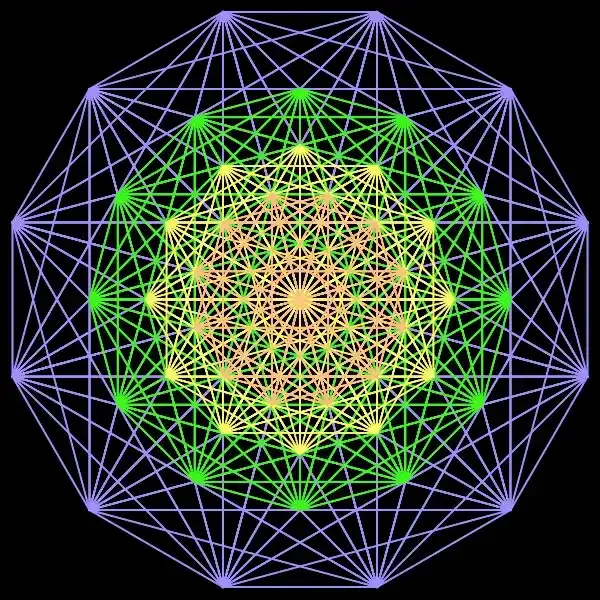Lie Algebras and Groups
USOSLie algebras describe infinitesimal symmetries of physical systems. Therefore, they and their representation theory are extensively used in physics, most notably in quantum mechanics and particle physics. This course introduces semi-simple Lie algebras and the associated Lie groups for physicists. We discuss the essential tools, like the root and weight system, to efficiently work with them and their representations. As on explicit application of the mathematical framework, we discuss Grand Unified Theories (GUT). Moreover, we show how modern computer algebra tools like LieART can significantly help in all explicit computations throughout the course.
 A simple example is the visualisation of the root system of projected on the Coxeter plane, which you can see here. If you want to understand how it is created and connected to particle physics, you should take this course. Basic knowledge of core concepts in linear algebra, like vector spaces, eigenvalues and eigenvectors, is assumed. Some good books about the topic are:
A simple example is the visualisation of the root system of projected on the Coxeter plane, which you can see here. If you want to understand how it is created and connected to particle physics, you should take this course. Basic knowledge of core concepts in linear algebra, like vector spaces, eigenvalues and eigenvectors, is assumed. Some good books about the topic are:
- Fuchs and Schweigert: Symmetries, Lie Algebras and Representations
- Gilmore: Lie Groups, Lie Algebras, and Some of Their Applications
- Fulton and Harris: Representation Theory
- Georgi: Lie Algebras In Particle Physics: from Isospin To Unified Theories
The article Phys. Rep. 79 (1981) 1 by Slansky and the manual of the LieART package are good references, too.
Note: At multiple occasions, we will use Mathematica and it might be a good idea to set it up on your computer. Following the instructions below you should be eventually able to run the
Exam: As we decided together, the exam will be a written exam. It will take place on Friday, the 1st of July 2022 at 10:00 am in room 511. Note that we will start at this time! Please, be there a bit earlier to avoid problems. To prepare for the exam, you should have a look at the practise exam. It may give you a better idea about possible questions and is intended to help you prepare. Take it serious and try to solve it in two hours.
Retake Exam: We now have a consensus for the date of the retake exam. It will take place at Wednesday, the 7th of September 2022 10:00 am in room 447 (the same room where we had the lectures).
Lectures
- Introduction and motivationLecture28.02.2022 11:15
- Some mathematical preliminariesLecture07.03.2022 11:15
- Classical matrix groupsLecture14.03.2022 11:15
- Cartan subalgebraLecture21.03.2022 11:15
- Root systemLecture28.03.2022 10:15
- Simple root and Cartan matrixLecture04.04.2022 10:15
- Classification and Dynkin diagramsLecture11.04.2022 10:15
- Irreducible representationsLecture25.04.2022 10:15
- () representations and Young tableauxLecture02.05.2022 10:15
- Highest weight representationsLecture09.05.2022 10:15
- Characters and Weyl groupLecture16.05.2022 10:15
- Decomposition of tensor products and regular subalgebrasLecture23.05.2022 10:15
- Special subalgebras and branching rulesLecture30.05.2022 10:15
- Particle theory and the standard modelLecture05.06.2022 22:00
- The Georgi–Glashow modelLecture13.06.2022 10:15
